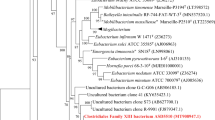Abstract
Most probable number (MPN) estimates indicated that a mean of 4.3×107 and 5×106 bacteria per ml of rumen fluid from a predominantly alfalfa hay-fed steer demethoxylated ferulate and syringate, respectively. After further enrichment from an MPN tube of the highest dilution showing demethoxylation of syringate, strain S195 was isolated using roll tubes with syringate as an added energy source. S195 was an anaerobic, Gram-negative, nonmotile coccus, 1 to 1.3 μm in diameter, and was unique in using various carbohydrates as electron donor with acetate as the sole organic product. One of the following electron acceptor systems allowed growth (organic products in parentheses): Methanobrevibacter simithii (CH4), formate (acetate), 3,4,5-trimethoxybenzoate and syringate (acetate and gallate), vanillate (acetate and protocatechuate), vanillin (acetate, protocatechuic aldehyde and protocatechuate), ferulate (acetate, caffeate and hydrocaffeate), caffeate (hydrocaffeate). Strain S195 required 30% (v/v) rumen fluid in the medium for good growth. S195 was placed in a new genus and species, Syntrophococcus sucromutans, of the family Veillonellaceae.
Similar content being viewed by others

Abbreviations
- G+C:
-
Guanine plus cytosine
- MPN:
-
most probable number
- OD:
-
optical density
References
Ashwell G (1966) New colorimetric methods of sugar analysis. In: Newfield EF, Ginsberg V (eds) Methods in enzymology. Complex carbohydrates. Academic Press, New York, vol 8, pp 85–95
Bache R, Pfennig N (1981) Selective isolation of Acetobacterium woodii on methoxylated aromatic acids and determination of growth yields. Arch Microbiol 130:255–261
Balch WE, Wolfe RS (1976) New approach to the cultivation of methanogenic bacteria: 2-Mercaptoethanesulfonic acid (HS-CoM)-dependent growth of Methanobacterium ruminantium in a pressurized atmosphere. Appl Environ Microbiol 32:781–791
Balch WE, Schoberth S, Tanner RS, Wolfe RS (1977) Acetobacterium, a new genus of hydrogen-oxidizing, carbon dioxide-reducing, anaerobic bacteria. Int J Syst Bacteriol 27:355–361
Booth AN, Williams RT (1963) Dehydroxylation of catechol acids by intestinal contents. Biochem J 88:66P-67P
Chesson A, Stewart CS, Wallace RJ (1982) Influence of plant phenolic acids on growth and cellulolytic activity of rumen bacteria. Appl Environ Microbiol 44:597–603
Genthner BRS (1984) The biology of Eubacterium limosum and its utilization of one carbon compounds. Ph D Thesis, Univ of Illinois, Urbana
Genthner BRS, Davis CL, Bryant MP (1981) Features of rumen and sewage sludge strains of Eubacterium limosum, a methanol-and H2−CO2-utilizing species. Appl Environ Microbiol 42:12–19
Kaiser JP, Hanselmann KW (1982) Fermentative metabolism of substituted monoaromatic compounds by a bacterial community from anaerobic sediments. Arch Microbiol 133:185–194
Kandler O, Konig H (1978) Chemical composition of the peptidoglycan free cell walls of methanogenic bacteria. Arch Microbiol 118:141–152
Krumholz LR, Bryant MP (1985a) Eubacterium oxidoreducens sp. nov. requiring H2 or formate to degrade gallate, pyrogallol, phloroglucinol and quercetin. Arch Microbiol (in press)
Krumholz LR, Bryant MP (1985b) Clostridium pfennigii sp. nov. uses methoxyl groups of mono-benzenoids and produces butyrate. Int J Syst Bacteriol 35:454–456
Lorowitz WH, Bryant MP (1984) Peptostreptococcus products strain that grows rapidly with CO as the energy source. Appl Environ Microbiol 47:961–964
Lovley DR, Greening RC, Ferry JG (1984) Rapidly growing rumen methanogenic organism that synthesizes coenzyme M and has high affinity for formate. Appl Environ Microbiol 48:81–87
Martin AK (1982) The origin of urinary aromatic compounds excreted by ruminants 3. The metabolism of phenolic compounds to simple phenols. Br J Nutr 48:497–507
Robinson JA, Strayer RF, Tiedje JM (1981) Method for measuring dissolved hydrogen in anaerobic ecosystems: Application to the rumen. Appl Environ Microbiol 41:545–548
Rogosa M (1984) Veillonellaceae. In: Krieg NR (ed) Bergey's manual of systematic bacteriology. Williams and Wilkins Co. Baltimore, MD, vol 1, pp 680–681
Scheline RR (1966) Decarboxylation and demethylation of some phenolic benzoic acid derivatives by rat cecal contents. J Pharm Pharmac 18:664–669
Scheline RR (1978) Mammalian metabolism of plant xenobiotics. Academic Press, London
Schleifer KH, Kandler O (1972) Peptidoglycan types of bacterial cell walls and their taxonomic implications. Bacteriol Rev 36:407–477
Thauer RK, Jungermann K, Decker K (1977) Energy conservation in chemotrophic anaerobic bacteria. Bacteriol Rev 41:100–180
Author information
Authors and Affiliations
Rights and permissions
About this article
Cite this article
Krumholz, L.R., Bryant, M.P. Syntrophococcus sucromutans sp. nov. gen. nov. uses carbohydrates as electron donors and formate, methoxymonobenzenoids or Methanobrevibacter as electron acceptor systems. Arch. Microbiol. 143, 313–318 (1986). https://doi.org/10.1007/BF00412795
Received:
Accepted:
Issue Date:
DOI: https://doi.org/10.1007/BF00412795



